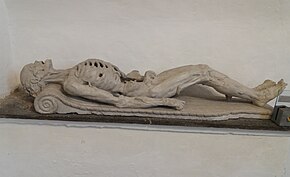

A cadaver monument or transi is a type of funerary monument to a deceased person, featuring a sculpted tomb effigy of a skeleton, or of an emaciated or decomposing dead body, with closed eyes. It was particularly characteristic of the Late Middle Ages[2] when they were designed to remind viewers of the transience and vanity of mortal life, and the eternity and desirability of the Christian after-life. The format is in stark contrast to gisants, which are always recumbent, in full dress, with open eyes and hands clasped and raised in prayer.[3][4]
Cadaver monuments first appeared in the 1380s and remained a popular form of funerary art for 200 subsequent years.[5] In a still widely debated theory popularized by the historians Helen M. Roe and John Aberth,[6] cadaver monuments are often interpreted as a form of memento mori or adaption of the motif of "The Three Living and the Three Dead". They show the human body's "transition" from life to decomposition,[7] highlighting the contrast between worldly riches and elegance and the degradation of death.[4]
Over the centuries, the depictions became more realistic and gruesome, while earlier tendencies to line the tombs with moralizing inscriptions on the vanities of life were abandoned. The morbid art form reached its peak in the late 16th century, with more extreme effigies depicting putrefied corpses outside of the funerary monument context, and taking centre stage as stand-alone sculptures.[8]
- ^ Cadaver Monument of Guillaume de Harcigny (D. 1393). Church Monument Society, 2010. Retrieved 25 June 2023
- ^ Cohen, Kathleen (1973). Metamorphosis of a Death Symbol: The Transi Tomb in the Late Middle Ages and the Renaissance. Berkeley: University of California Press.
- ^ Cohen (1974), p. 9
- ^ a b Covi (1975), p. 385
- ^ Heimerman (2021), p. 3
- ^ Heimerman (2021), p. 7
- ^ Cohen (1974), p. 179
- ^ Bass (2017), p. 163